Books
Artists Kiki Smith, Kara Walker, and More Offer Novel Takes on Aesop’s Fables in a Lush New Book
None other than Lemony Snicket provides offbeat interpretations of the ancient lessons.
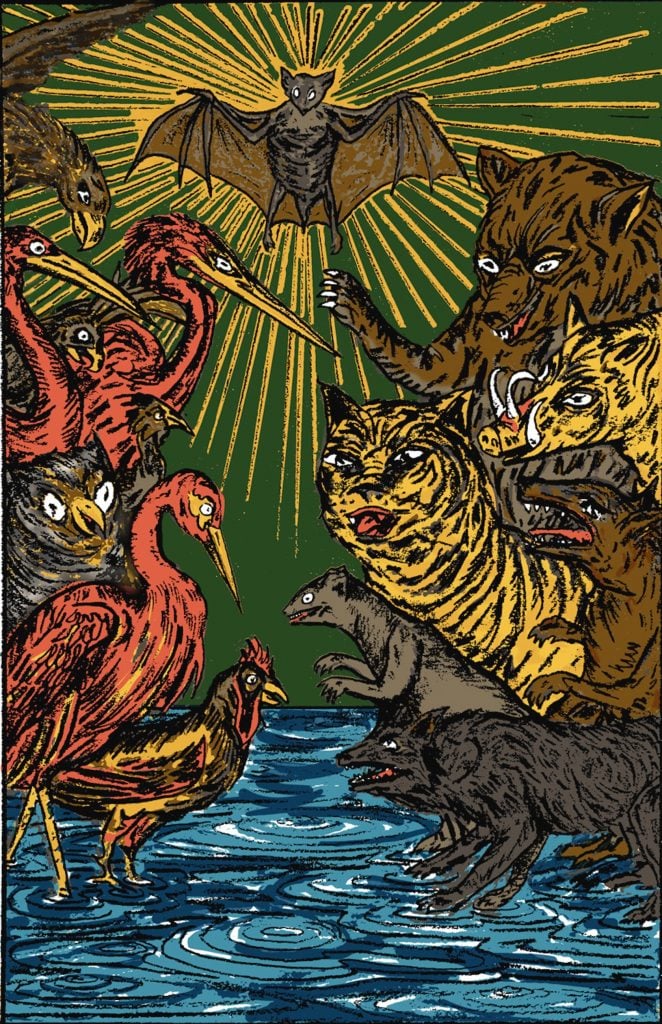
Sour grapes. Nature will out. The goose that laid the golden egg. The lessons embedded in Aesop’s Fables, the animal-rich tales that supposedly originated with an ancient Greek slave, are so embedded in our vocabulary that we may quote them without even recalling their origins. That makes sense, as they have traveled the world, originating from, translated into, and reinterpreted in many languages; some may be considered canonical, but numerous others have been added over time.
So it’s entirely fitting that 16 contemporary artists and a modern writer are offering new interpretations in a lush new book from San Francisco’s renowned Arion Press. Marcel Dzama illustrates the tale of the birds, the beasts, and the bat; Kiki Smith will create a box housing inspired by the fable of the cat and the bell; Kara Walker offers her take on the wolf in sheep’s clothing. The roster also includes figures like Magdalena Campos-Pons, Enrique Chagoya, Michele Oka Doner, Alison Saar, and Joel Shapiro. Author Daniel Handler, aka Lemony Snicket, provides his own tart summations.
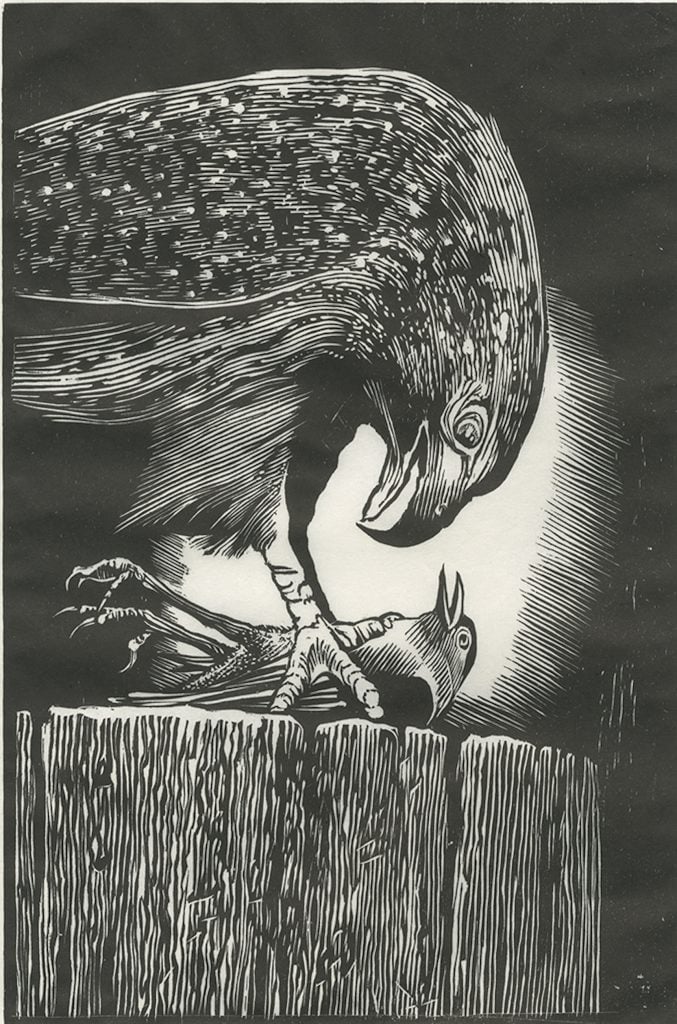
Barry Moser, The Hawk and The Nightingale. Published by The Arion Press, 2024.
The book celebrates the 50th anniversary of Arion’s founding, and comes at the same time that the press is moving from its longtime home in the Presidio to the Fort Mason Cultural Center, on the waterfront.
In keeping with the anniversary theme, the press invited back artists who have worked with the press over its five decades, during which it has published some 124 volumes, many bringing together text and image. These have seen apt pairings like Nikolai Gogol’s The Nose with artist William Kentridge; William Bentley’s mock screenplays Scenes from the Cutting Room Floor with John Baldessari; and Ira Gershwin’s Porgy and Bess with Walker.
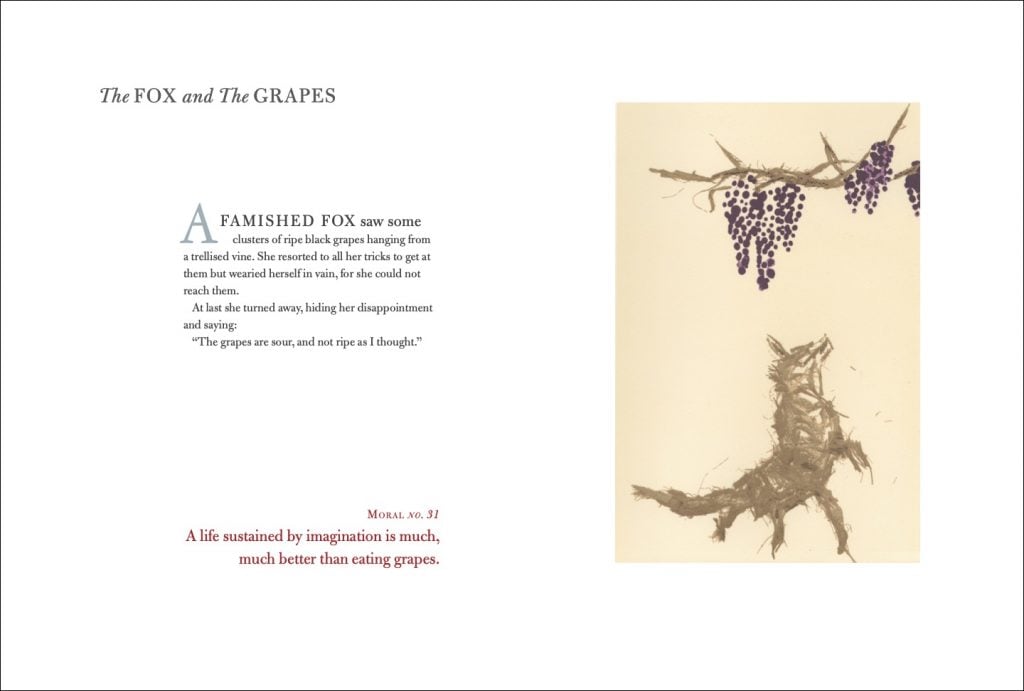
Michele Oka Doner, The Fox and the Grapes. Published by the Arion Press, 2024.
Printed matter enthusiasts can subscribe and get one of two versions of the books Arion creates each year, but at either price point, they aren’t casual purchases. A subscription to the deluxe editions of this year’s two offerings costs $10,000 and gets you, in addition to Aesop’s Fables, Octavia E. Butler’s Kindred (“a neo-slave narrative and fantasy hybrid where paradox informs social critique,” in Arion’s description) with prints by Alison Saar. A “fine print” 2024 edition of the two can be had for just $2,400. (A few years back, some book lovers lamented online that they didn’t have $4,500 to spend on the press’s 1978 edition of Moby-Dick with woodcarvings by artist Barry Moser, which had in any case rapidly sold on eBay, making it, itself, a bit of a white whale.)
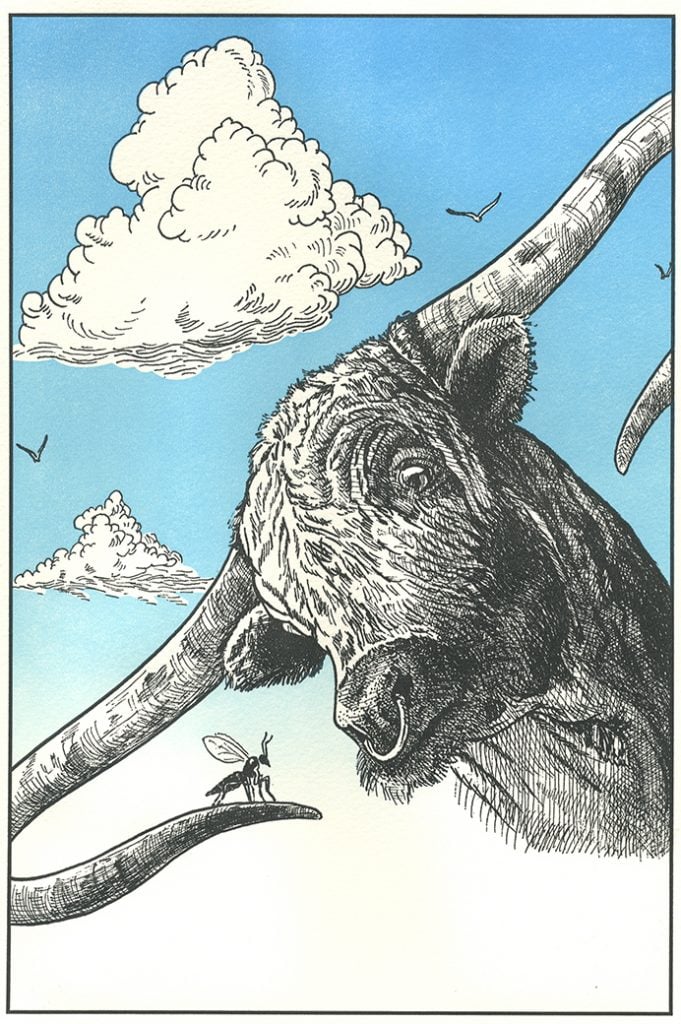
Sandow Birk, The Gnat and the Bull. Published by the Arion Press, 2024.
If the prices seem exorbitant, it’s important to remember that each volume commands thousands of human hours of labor by nearly two dozen employees. Given Arion’s reliance on labor-intensive and often ancient techniques, it might seem ironic that it resides in Silicon Valley, the area that is home to, just for one example, the company Bland A.I. (yes, really), which recently created controversy with a billboard asking, “Still hiring humans?”
But in a phone call, Blake Riley, Arion’s lead printer and creative director, pushed back on that to some degree. For one thing, there are long traditions of analog art-making techniques in the same region, he said, adding, “We embrace technology wherever we can, and having Silicon Valley in our backyard helps with that.”
The Aesop’s Fables project suited Arion’s needs in a few ways, said Riley, outlining how technical and creative solutions intertwined. The anniversary called for something with global appeal—the Fables are probably the second-most-published book in the Western world, he said—and the move suggested something that could be conceived in a modular fashion, given the unpredictable state of the shop during the dismantling of its many tons of equipment. The box that Smith is creating will hold individual folios, with each fable represented on its own sheet of paper, granting some flexibility, Riley said.
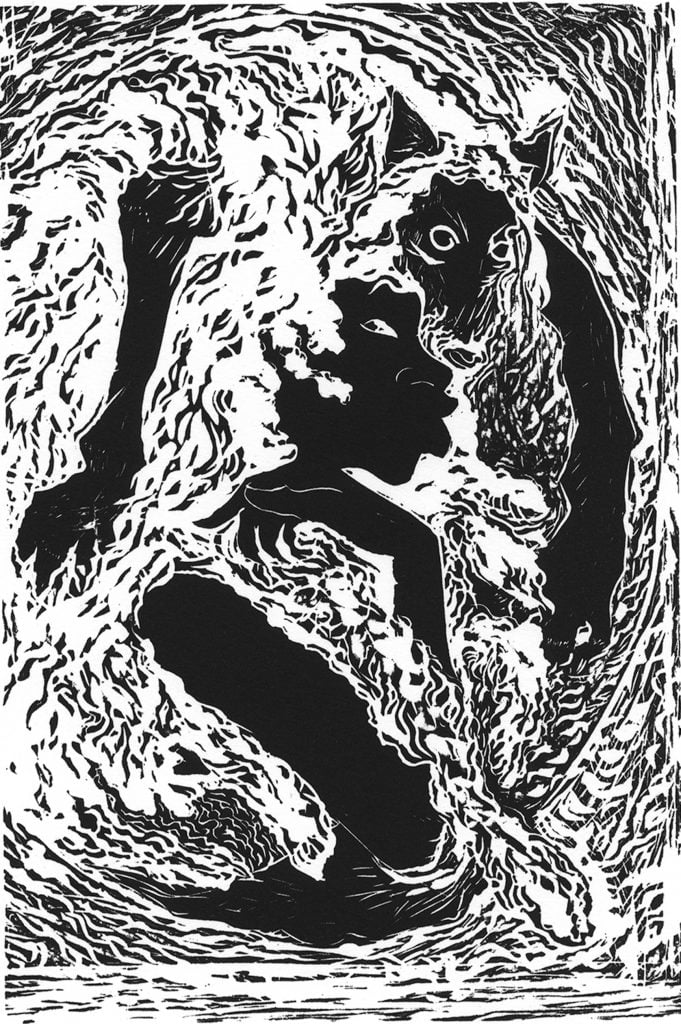
Kara Walker, The Wolf in Sheep’s Clothing. Published by the Arion Press, 2024.
The creators at Arion felt they had to bring something special to the table, he recalled.
“We could take on something as grand as Aesop’s Fables, but we asked, ‘What can we bring to it that makes it speak to this time?’” said Riley. “We realized that if we rewrite the morals, then we have a contemporary contribution to this great legacy. That’s when we began to consider writers and satirists. Daniel Handler was loosely in our orbit, and he snatched it up right away. He’s really risen to the occasion.”
Handler, for his part, said that the project resonated with him on several levels.
“I had a few different editions that were leftovers from various other people’s childhood bedrooms,” he said in a phone conversation. “The format really intrigued me. They’re so explicit in their meaning, and frequently I would think, ‘So that’s what it means? That doesn’t seem right to me!’ I enjoyed thinking there was something off about the transition from a story to its meaning. So when they approached me about this project, it was literally a dream I had had some 45 years or so before.”
The project also resonated with his cultural background.
“In the Jewish tradition,” he said, “the holiest thing you can do is sit around and argue about what a tiny piece of text means.”
Having chosen a roster of artists, Arion asked them to supply a ranked list that they’d like to illustrate. New York artist Natalie Frank got her first choice, the tale of a cat and the goddess Venus. Frank has carved out a bit of a niche working with fairy tales and other dark literature, having also drawn, for example, illustrations for a book of “unsanitized” versions of Tales of the Brothers Grimm; a Jack Zipes-edited The Sorcerer’s Apprentice: An Anthology of Magical Tales; and, for Arion, a volume of stories and poems by Edgar Allan Poe.
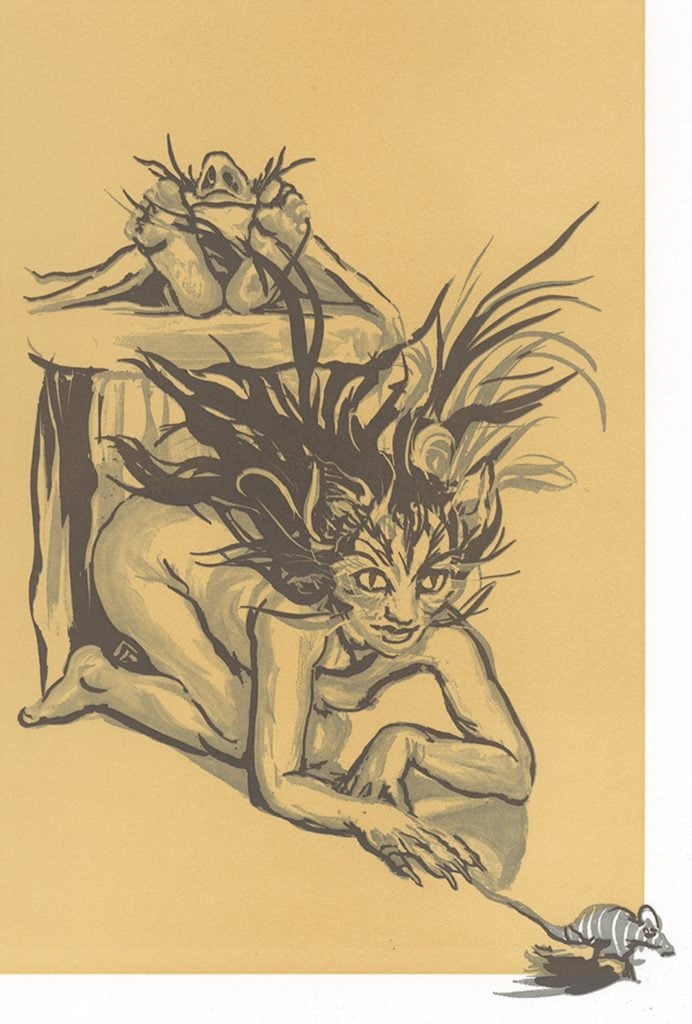
Natalie Frank, The Cat and Venus. Published by the Arion Press, 2024.
“It’s about a cat who falls in love with a handsome young man and asks Venus to change her into a woman so she can be with him,” Frank said in a phone call. “Later, Venus tests her by releasing a cat into their bedroom, and when the woman chases the mouse, Venus realizes that the cat-woman still has her cat nature.”
Frank’s rendition of the scene shows the cat-woman in pursuit of her quarry, in the midst of her transformation back into a cat, and, behind her, the horizontal man viewed from the foot of the bed where he lies.
“I always like to focus on images of women, so I knew she would be the protagonist and that the way to represent him would be almost like a corpse, with his feet and nose pointing up,” she said. “I was also thinking of Kentridge, an artist I love, and the nose was a nice gesture toward that. I was also implying that between the feet and the nose, there might be another vertical shape standing up, but I wanted it to be just a hint of that.
“The woman is in mid-transformation, and the mouse is getting away,” she said, adding that that approach to picture-making was suggested by another artist she admires. “Paula Rego always used to say that it’s good to give the viewer a way in and a way out of an artwork, something that maybe gestures toward the edges.”
While a traditional moral to the tale might read something like “Nature will out,” Handler provides a perhaps more matter-of-fact read: “Even the most devoted of lovers can surprise you.”
Daniel Handler will moderate an October 19 panel discussion with participating artists Sandow Birk, Enrique Chagoya, Kenturah Davis, Natalie Frank, Audrey Niffenegger, Michele Oka Doner, and Richard Wagener.





